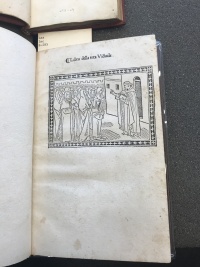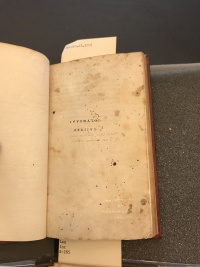Titles/Title Pages/Incipits/Colophons: Difference between revisions
| Line 2: | Line 2: | ||
== History == | == History == | ||
There are four main ways to identify a book, and each have their own unique place in book history. Incipits derive from antiquity and much like a title, are used to introduce the reader to a text, taking place as the first few words of a text. But unlike the title, incipits employ the author’s voice, and serve as an almost conversational introduction. <ref>Shevlin, “‘To Reconcile Book and Title, and Make ‘em Kin to One Another,’: The Evolution of the Title’s Contractual Features.”</ref> The incipit was very common in medieval manuscripts and early printed books but has since lost popularity. However, a well-known work, Chaucer’s Canterbury Tales, begins with an incipit, “here begynneth ...” <ref>Shevlin, “‘To Reconcile Book and Title, and Make ‘em Kin to One Another,’: The Evolution of the Title’s Contractual Features.”</ref> Like the incipit, the life of the colophon [https://en.wikipedia.org/wiki/Colophon_(publishing) traces to antiquity]. The colophon [https://en.wikipedia.org/wiki/Colophon_(publishing) contains information about the publication of the book, and prior to the invention of the title page was placed in the back of the manuscript]. With the advent of the title page, the colophon moved to the back of the title page. Despite the shift, the colophon remains in existence today, just in different forms than its initial conception. For example, some [https://en.wikipedia.org/wiki/Colophon_(publishing) websites have colophons containing the XHTML]. | There are four main ways to identify a book, and each have their own unique place in book history. Incipits derive from antiquity and much like a title, are used to introduce the reader to a text, taking place as the first few words of a text. But unlike the title, incipits employ the author’s voice, and serve as an almost conversational introduction. <ref>Shevlin, “‘To Reconcile Book and Title, and Make ‘em Kin to One Another,’: The Evolution of the Title’s Contractual Features.”</ref> The incipit was very common in medieval manuscripts and early printed books but has since lost popularity. However, a well-known work, Chaucer’s Canterbury Tales, begins with an incipit, “here begynneth ...” <ref>Shevlin, “‘To Reconcile Book and Title, and Make ‘em Kin to One Another,’: The Evolution of the Title’s Contractual Features.”</ref> Like the incipit, the life of the colophon [https://en.wikipedia.org/wiki/Colophon_(publishing) traces to antiquity]. The colophon [https://en.wikipedia.org/wiki/Colophon_(publishing) contains information about the publication of the book, and prior to the invention of the title page was placed in the back of the manuscript]. With the advent of the title page, the colophon moved to the back of the title page. Despite the shift, the colophon remains in existence today, just in different forms than its initial conception. For example, some [https://en.wikipedia.org/wiki/Colophon_(publishing) websites have colophons containing the XHTML]. While the existence and use of incipits and colophons has faded due to the inventions of titles and title pages, incipits and colophons still remain important book technologies. | ||
Titles derive from the latin word Titulus, translated as “inscription, label, notice, title of honor, fame, pretext” <ref>Adams, "Titles, Titling, and Entitlement To," 8.</ref> <== | |||
== Analysis of Objects == | == Analysis of Objects == | ||
Revision as of 01:53, 4 December 2018
How do you identify a book? In current times, most people would answer this seemingly obvious question with “the title.” But relatively speaking, the title, and its associated technologies of the title page, incipit, and colophon have only been around for so long; each of these technologies had to be invented. Prior to these inventions, books were designated by other means. For example, clay tablets were designated by numbers, Ancient Hebrew texts by the first few words (comparable to an incipit), and even the ancient oral stories of Greece and Rome were titled after the fact, most likely by scribes or grammarians. [1] Following this age, titling devices were invented, and tracing the trajectory of titles, title pages, incipits, and colophons throughout book history proves valuable not only bibliographically, but when looking toward the current digital incunable age.
History
There are four main ways to identify a book, and each have their own unique place in book history. Incipits derive from antiquity and much like a title, are used to introduce the reader to a text, taking place as the first few words of a text. But unlike the title, incipits employ the author’s voice, and serve as an almost conversational introduction. [2] The incipit was very common in medieval manuscripts and early printed books but has since lost popularity. However, a well-known work, Chaucer’s Canterbury Tales, begins with an incipit, “here begynneth ...” [3] Like the incipit, the life of the colophon traces to antiquity. The colophon contains information about the publication of the book, and prior to the invention of the title page was placed in the back of the manuscript. With the advent of the title page, the colophon moved to the back of the title page. Despite the shift, the colophon remains in existence today, just in different forms than its initial conception. For example, some websites have colophons containing the XHTML. While the existence and use of incipits and colophons has faded due to the inventions of titles and title pages, incipits and colophons still remain important book technologies.
Titles derive from the latin word Titulus, translated as “inscription, label, notice, title of honor, fame, pretext” [4] <==
Analysis of Objects
Returning to a time when it was nearly impossible to judge a book by its cover, Rare Book Rooms and Special Collections, such as the University of Pennsylvania’s Rare Book and Manuscript Library, demonstrate the transitory qualities of incipits, titles, title pages, and colophons through incunables and early printed books.
An examination of three manuscripts from Penn’s Rare Book and Manuscript Library, allows for a comparison between the role of titles, title pages, incipits, and colophons in the transitory time of printing (around the 1500s). Libro della vita Viduale’s [1490] first identification comes in the form of a title page, home to just this title and an ornate woodcut (Figure 1).


Cataloguers at Penn think it to be by Girolamo Savonarola, but there is no name on the title page. However, Libro della vita Viduale’s incipit announces the commencement of the text as well as the name, Hieronymo, which is thought to be Savonarola (Figure 2). Penn’s catalogue of this work believes its publication to be, Florence : Bartolommeo di Libri, ca. 1490, which was otherwise not denoted in the book. Such information would be typical of the colophon, or back of the title page, but for this incunable no such information exists on the manuscript. However, digitization allows for such information to come to light. Iuuenalis Persius [1501], a very early printed book, follows the tradition of Libro della vita Viduale by having a title page just containing the title (Figure 3). However, on the back of the title page, Iuuenalis Persius contains a note from famous Italian printer, Aldus Manutius, to Scipio, essentially saying that he made a shorter book (Manutius invented a new size format) (Figure 4). In this instance, the title page contains some of its current information as the identity of the printer is known; however, it also demonstrates the liberty of printers during this time. Penn cataloguers believe the publication to be, Venetiis, in dibus Aldi. mense augusto, 1501, which would have otherwise been unknown by just observing the manuscript. Libro della vita Viduale and Iuuenalis Persius were published within eleven years of one another. Both serve to demonstrate the coexistence of the title, incipit, title page, and colophon as identification devices. In addition, both these works are staples of the incunable period as printers and publishers had not yet figured out the standard for identifying the title pages, so the works wound up having a collision of different devices. It is interesting to think about: how would someone have identified these books at the time of publication? By their title pages?

Notes
- ↑ Levin, “The Title as a Literary Genre,” pg. xxiv-xxv.
- ↑ Shevlin, “‘To Reconcile Book and Title, and Make ‘em Kin to One Another,’: The Evolution of the Title’s Contractual Features.”
- ↑ Shevlin, “‘To Reconcile Book and Title, and Make ‘em Kin to One Another,’: The Evolution of the Title’s Contractual Features.”
- ↑ Adams, "Titles, Titling, and Entitlement To," 8.
Works Cited
Levin, Harry. “The Title as a Literary Genre.” The Modern Language Review, vol 72, no. 4, Published by Modern Humanities Research Association, October 1977, pp. xxiii-xxxvi, JSTOR. https://www.jstor.org/stable/3724776
Shevlin, Eleanor, F. “‘To Reconcile Book and Title, and Make ‘em Kin to One Another,’: The Evolution of the Title’s Contractual Features.” Book History, vol 2, 1999. Johns Hopkins University Press. http://muse.jhu.edu/article/3592